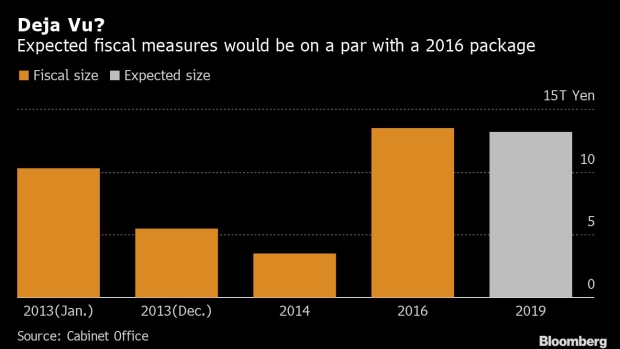Dec 4, 2019
Japan to Unveil Details of Fiscal Stimulus as Early as Thursday
, Bloomberg News

(Bloomberg) -- Japanese Prime Minister Shinzo Abe is expected to announce a stimulus package as soon as Thursday to support growth in an economy contending with an export slump, natural disasters and the fallout from a recent sales tax increase.
The stimulus measures are likely to have a headline figure of about 25 trillion yen ($230 billion), according to a senior Abe administration official, making it equivalent to around 4.5% of gross domestic product at face value. Still, economists and investors will be watching how much fresh spending the package actually contains and how much financing it will require.
Japan Cherry Blossom Scandal Starts to Drag Down Abe Support
With the package, Abe looks intent on minimizing the risk of a recession that would tarnish the record of his Abenomics growth program, while shoring up his own political support after recent scandals. To that end, an array of measures with a large price tag that can be paid for with the bare minimum of extra borrowing would fit the bill for a country with the developed world’s largest debt load.
Japan’s economy is forecast to shrink 2.7% in annualized terms this quarter, following the tax hike and a destructive typhoon, according to economists surveyed by Bloomberg. The package would aim to get Japan’s economy up and running again and avoiding a further deterioration in global demand triggering a recession early next year.
A draft of the government stimulus package obtained by Bloomberg sets out the need for spending on upgrading disaster-prevention infrastructure, an extension of a cashless-payment rebate program and information technology help for small and mid-sized companies that are raising wages. The draft didn’t set out how much money would be spent, though Liberal Democratic Party policy chief Fumio Kishida said Tuesday that its economic measures would go well beyond 10 trillion yen.
Japan’s Government Calls for Decisive Fiscal Action
The headline figure is typically inflated with promised loans and private-sector assistance. But even if the main fiscal measures reach 13 trillion yen, in line with the scale of a 2016 package, the amount of financing required in an extra budget would likely be far less, especially if funding is spread into next year’s regular budget. Extra budget financing for the 2016 stimulus came to only 3.5 trillion yen.
An immediate spending bump of that size might not have such an impact on the economy. In a note to clients, Citigroup economists Kiichi Murashima and Katsuhiko Aiba said the package’s effect on growth was likely to be limited because any spending on public works would be spread out quite gradually over time. The stimulus would expand gross domestic product by no more than 0.4 percentage point in the fiscal year starting April 2020, they wrote.
What Bloomberg’s Economist Says
“Japan’s latest economic package isn’t likely to boost growth by much, but it should be enough to avoid a contraction this quarter turning into a recession early next year. That said, Prime Minister Shinzo Abe may need to ramp up the fiscal stimulus in 2020 if overseas demand deteriorates again.”
--Yuki Masujima, economist
Click here to read more.
--With assistance from Emi Urabe and Emi Nobuhiro.
To contact the reporters on this story: Toru Fujioka in Tokyo at tfujioka1@bloomberg.net;Yoshiaki Nohara in Tokyo at ynohara1@bloomberg.net
To contact the editors responsible for this story: Malcolm Scott at mscott23@bloomberg.net, Jason Clenfield, Paul Jackson
©2019 Bloomberg L.P.


